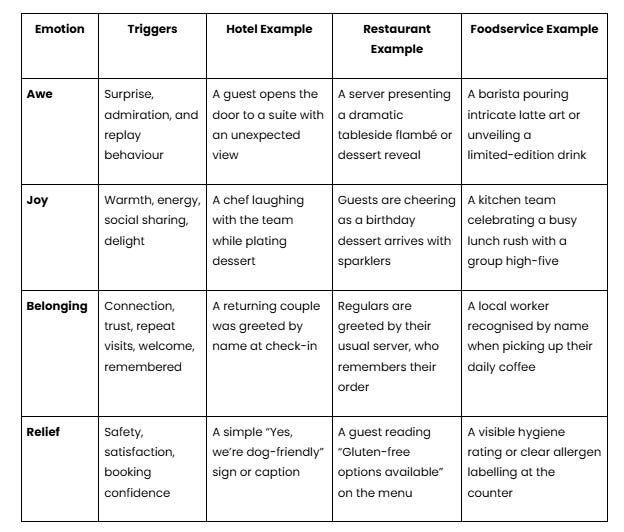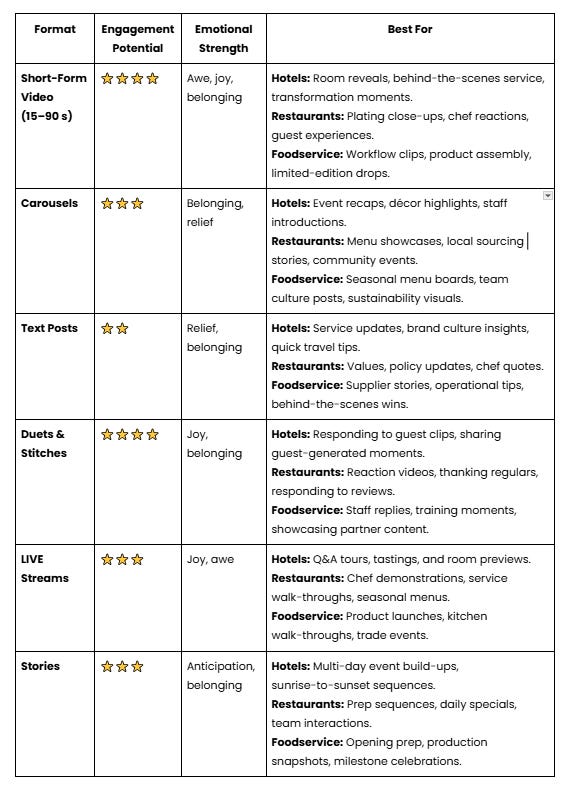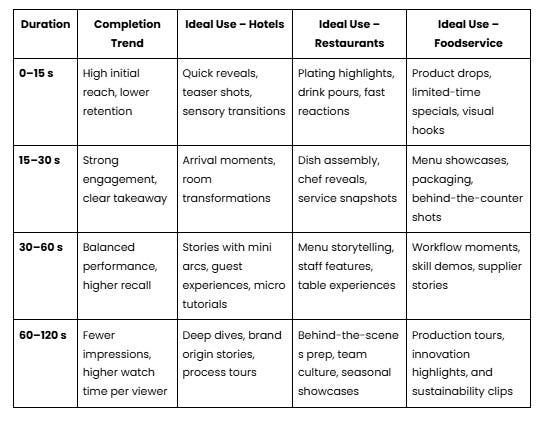📌 TikTok for Hospitality: Strategy, Storytelling, and Science
Every second counts. Here’s how to make yours memorable.
Is TikTok right for our venue? What types of video perform best? Where do I even start?
🌞 Hello and Welcome To Hospitality Marketing Insight, I’m your host, Dawn Gribble, and this week we’re deconstructing successful TikToks into their core ingredients. This is part of the TikTok for Hospitality series.
TikTok drives huge discovery, yet the industry still hesitates. Fear of less-controlled messaging holds teams back while guest attention moves on. The result is a widening gap between where audiences spend time and where brands invest.
TikTok now attracts approximately 1.6 billion monthly users, close to Instagram’s 2 billion and more than three times X at 560 million.
TikTok says its platform is already a powerful driver of travel intent. 66% of users consider it their most helpful source of travel inspiration, and they are 2.6 times more likely to book an experience after searching on the app, according to Hotel Industry Insights.
TikTok has also become a major traffic driver for restaurants and foodservice. The visual nature of the platform is key, with 72% of users saying that seeing appealing food imagery directly prompted them to try the restaurant. Among venues that market actively on TikTok, 78% reported a positive return on investment within six months.
Yet, only 31% of marketers use TikTok. The current hesitation around TikTok echoes earlier doubts about Instagram or YouTube in their infancy. But history shows that early adopters of new media reap outsized rewards.
In short, TikTok is right for your venue. The evidence is clear: it drives discovery, influence, and bookings across the hospitality industry. Today I’ll show you what types of videos perform best, how to plan them around emotion rather than trends, and how to get started with content that actually converts.
📄 On the Menu
Your TikTok Questions Answered
Micro-Storytelling Techniques
Matching Music to Mood
Plus Mistakes to Avoid and VIP Exclusive Insights
Let’s Check In ☕
💬 Your TikTok Questions Answered
Many savvy operators ask me the same question: how does TikTok translate into tangible results for a hotel, restaurant, or food brand? It’s a multi-faceted concern, so let’s start with the question I hear most often
🧬 Why is TikTok so different to other social media channels?
TikTok isn’t just a short-video app or social media platform; it’s an emotional ecosystem. The platform measures reaction, not just reach. Every pause, replay, and share is a data point that tells TikTok:
“This clip made someone feel something.”
TikTok’s strongest content works because it triggers emotion, not just attention. The most powerful are awe, joy, belonging and relief. These are the same feelings that shape memorable stays and meals. Simple sensory moments, such as a door clicking open, a pour, or a smile, often outperform high-budget edits because they feel genuine.
Authenticity and personal connection are huge factors in TikTok’s success. Content that feels real, like “behind-the-scenes” rings true, especially with younger audiences. Gen Z users, in particular, value unfiltered, authentic voices; brands and creators who show real personality and honesty tend to gain trust. This authenticity translates into psychological connection – 73% of TikTok users say they feel a deeper “connection” to brands they interact with. In other words, TikTok’s casual, humanising style of content creates a sense of community and relatability that traditional polished ads or broadcast posts lack.
A word of caution: The platform’s algorithm tends to reward content that sparks strong reactions or heated discussion. Studies show that users often learn to post “spicier” or more provocative opinions because the algorithm amplifies what generates engagement. While this can boost reach, it also fuels emotional fatigue, polarisation, and anxiety for both creators and audiences. In hospitality, where tone, empathy, and trust matter, the cost of chasing outrage is higher than the benefit. Sustainable visibility should prioritise meaningful connection, not volatility. Ethical marketing means protecting your audience’s well-being as much as their attention.
Emotional Drivers
When you plan TikToks around these emotions, you create immersive experiences. The same principles that build loyalty on-site also create reach and recall online.
Adapt this table for your venue
These scenarios are easily captured on camera. A sign that reassures, a welcome that feels personal or a moment of laughter in service can all become simple stories worth sharing.
Treat every TikTok as a micro-experience, from arrival to reveal to emotional payoff, because this is the psychology that turns passive viewers into future guests.
🎥 What Content Should We Create for TikTok?
Short-form video now accounts for more than 80% of online traffic, and on TikTok, it consistently outperforms every other format, earning around 18% more views than text and 7% more than photos or carousels. Different formats serve different purposes; some grab attention, others build trust. The key is knowing when to use each one.
TikTok Content for Hospitality
Each format taps into different emotions that shape guest perception. Combine content types in your campaigns to strike a balance between ease of production and emotional impact, creating content that both connects and converts.
🕒 How Often Should We Post to TikTok?
According to Buffer, posting 2 to 5 times per week at a minimum delivers the biggest lift in reach and engagement. This range provides the best return for your effort without overstretching your team or oversaturating your audience.
Accounts posting 2–5 times a week saw a roughly 15% increase in views per post, with performance continuing to rise for higher frequencies; however, this is contingent on consistency.
Start with a pace you can maintain. One strong, well-structured video each week is enough to test your workflow and audience rhythm. Document the process, track what works, and refine before scaling. Consistency matters more than output. The goal is a repeatable system, not burnout.
🎞️ How Long Should Our TikToks Be to Get Good Reach?
TikTok’s algorithm rewards videos that hold attention because they keep people on the platform longer. While 86% of TikToks are under a minute, those over 60 seconds deliver far better results. Once you cross that one-minute mark, performance climbs sharply, resulting in
43% more reach than videos in the 30–60 second range
70% more reach than videos in the 10–30 second range
95% more reach than videos in the 5–10 second range
Optimal Video Lengths for Hospitality
The best TikTok length depends on what you want the viewer to feel and remember. In hospitality, every duration serves a role, from quick sensory moments that spark curiosity to longer clips that build connection and brand story.
Longer videos can still work when they feel natural to the platform. A great example is Hilton’s 10-minute TikTok, which featured Paris Hilton and a mix of popular creators. The campaign broke from the usual format with humour and self-awareness, openly acknowledging that it was an ad while still keeping viewers entertained.
It didn’t feel like one long promotion. Each section flowed into the next, utilising different trends, creators, and tones to maintain attention. The video felt like scrolling through TikTok without needing to swipe. That blend of familiarity, playfulness and honest storytelling made it stand out.
Hilton’s success stemmed from the balance of creativity and authenticity, rather than solely from the length of the video. For most venues, the ideal range remains under two minutes. But Hilton proved that when story, pacing and tone work together, attention can stretch far beyond the usual limits.
By now, you’re probably wondering how to tell a story in seconds, why music matters so much, and what it really takes to plan TikToks that perform.
This week in the Lounge
🌟 Microstorytelling
🎵 Matching Music to Mood
💼 Ready-Made TikTok Recipes for Your Venue
Do you want to get ahead of your competitors without the consulting fee?
Join me in the VIP Lounge 👇
🎬 Micro Storytelling
Micro storytelling is the art of telling a complete story in seconds. Every scene has a purpose — the welcome, the reveal, the payoff. It connects curiosity to satisfaction in the same way a fantastic stay or meal unfolds from first impression to final moment. Think of it as hospitality in miniature: guiding the guest from arrival to satisfaction in under a minute.
Six-Ingredient Story Framework
These six ingredients form the foundation of every effective TikTok. You don’t have to include all of them in every post, but it’s essential to know which ones you’re using and what role they play. Think of them as the creative components that shape your story, the same way ingredients combine to create flavour and texture.
Keep reading with a 7-day free trial
Subscribe to Hospitality Marketing Insight to keep reading this post and get 7 days of free access to the full post archives.






